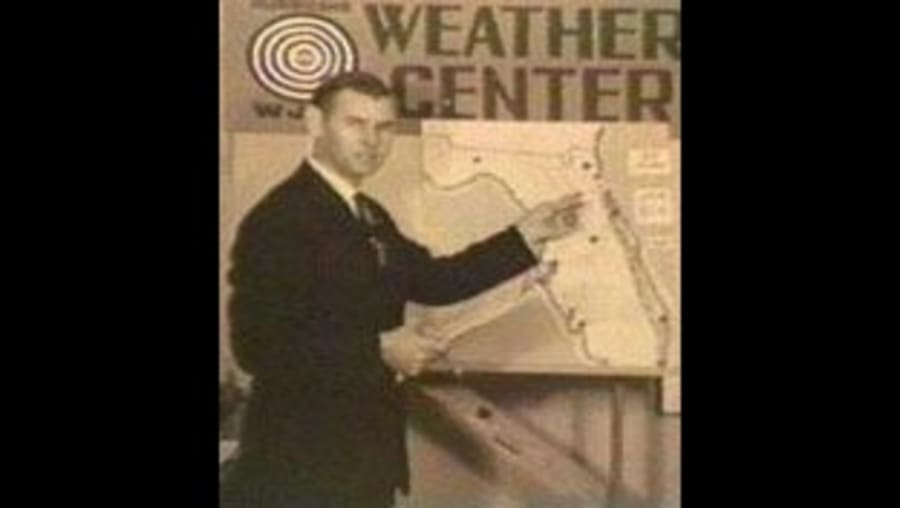JACKSONVILLE, Fla. – Anyone who has watched television in greater Jacksonville in the last half century knows George Winterling by name. What they probably don’t know is how Winterling developed a lifelong passion for the weather and how he helped invent the field of television weather forecasting.
George left his job at the National Weather Bureau and started at WJXT in 1962 -- the year of the Cuban missile crisis and when John Glenn made his Mercury space flight. Also that year, Walter Cronkite became the anchor of the CBS Evening News and Johnny Carson took over "The Tonight Show."
Over more than four decades of daily forecasting, he progressed from drawing his own weather maps with a Magic Marker to magnetic boards to static satellite maps to live radar, and most recently to 3D animations, complete with moving fronts, clouds and waves.
📷
How it began
Winterling can still recall the day in May 1937 when he spotted the ill-fated Hindenburg in the air near his New Jersey home prior to its fiery destruction.
After moving to a home on Ortega River in Jacksonville when he was 10, he witnessed aviation history being made during World War II when he saw military seaplanes in the St. Johns River near Naval Air Station Jacksonville and Hellcats, Avengers, and Corsairs taking to the skies.
It's no surprise that upon completion of high school in 1950 he joined the U.S. Air Force, but learned he needed two years of college to go into cadet training. Instead, Winterling studied meteorology in the Weather Observers School.
"They taught me the different clouds," Winterling said. "After I learned the different clouds and what made them and what they meant, it changed my life completely. I could never go anywhere without looking at the sky and understanding what the weather is doing and what the different cloud formations meant."
After initial training and advanced studies at the USAF's Intermediate Meteorology School at what is now Oklahoma State University, he spent most of his service in Alaska and in the Aleutian Islands, where he became familiar with typhoon-like storms that approached from the western Pacific Ocean.
After four years in the service, Winterling returned to Jacksonville to attend Jacksonville Junior College, then on to Florida State University where he received his degree in meteorology. After three years with the U.S. Weather Bureau -- now the National Weather Service -- Hurricane Donna spiked his interest in television weathercasting.
A start in broadcasting
He talked WJXT into needing a meteorologist to deliver the weather -- something unheard of at the time.

"I got into television in 1962 when I felt that the media needed knowledgeable persons doing weathercasts in times of emergencies," Winterling said. "In those early days, I painted clouds on maps, since there were no satellite pictures available."
In the early days, George designed and copyrighted the space-view weather maps to show viewers weather systems across the United States. He initiated predicting rainfall probability, and even chased storms and weather events, filming them with his 16mm camera.
He used that same camera to take single-frames to create animations to put the weather in motion.
Winterling was granted the American Meteorological Society Seal of Approval in 1963. He was appointed to the Board of Radio and Television Weathercasting in 1969 and designed the AMS television Seal of Approval in 1973.
Having reported summer temperatures in Florida's steamy humidity, Winterling developed in 1978 the humiture, which added a temperature equivalent moisture factor to the summer readings. A year later, the National Weather Service started the summer counterpart of the wind-chill factor called the heat index.
"It's the moisture-humidity factor that people say when its muggy, they say the atmosphere, it feels close," George said. "The reason it feels close is because the perspiration will not evaporate from your skin and it drenches you in sweat."
From 1975 to 1994, Winterling taught meteorology as an adjunct professor at Jacksonville University. In 1984, the AMS presented George with an award for outstanding service by a broadcast meteorologist honoring his skills and pioneering use of animation. The award was given to recognize his creative innovations to enable the public to better understand weather.
In 1989, Winterling passed the American Meteorological Society's exam to become a certified consulting meteorologist.
"I guess I'm getting to be the dinosaur because I've been in it since before computers. I've seen it change from film to videotape and now it's going digital, which has changed a lot of the way we do things," Winterling told the Jacksonville Daily Record in a 2006 interview.
George's Garden, a weekly feature Winterling created in the 1990s, has become a viewer favorite. Viewers get gardening tips on what to plant, how to grow it, when to fertilize, when to water and other timely tips.
Winterling has been married to his wife, Virginia, for 53 years. They have three children: Wendy Gale, Frank and Steve, as well as several grandchildren.





















